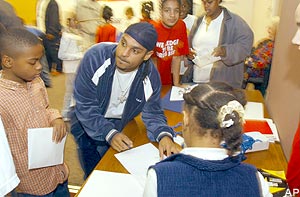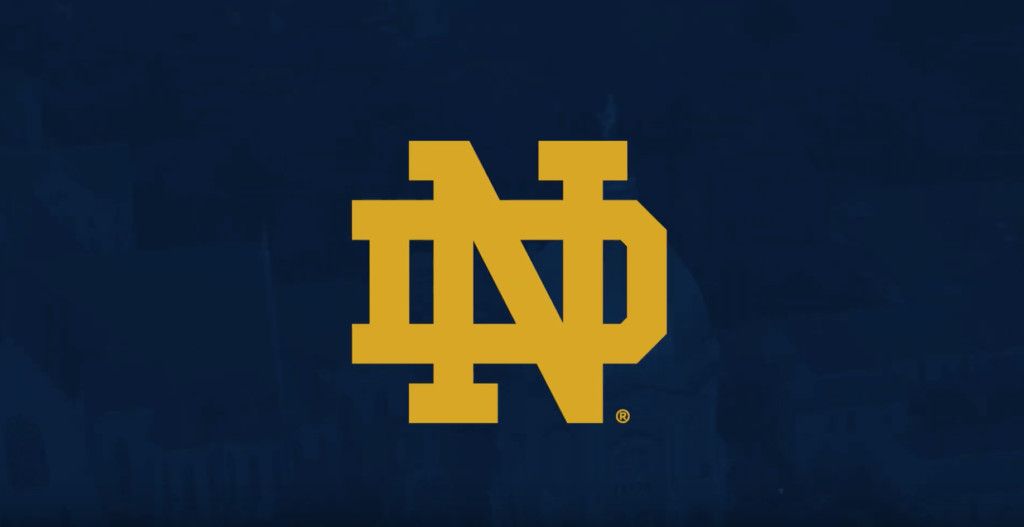Nov. 16, 2002
By TOM COYNE
AP Sports Writer
NOTRE DAME, Ind. (AP) – The noise was too loud to hear what he was saying, but Notre Dame cornerback Shane Walton was in a familiar position of talking to the person across from him, smiling the whole time.
Only this time, his opponent wasn’t 6-foot-4 receiver Charles Rogers from Michigan State or 6-7 Teyo Johnson of Stanford.
It was 3-foot-something Sarieta Walker of the South Bend Boys & Girls Club. The 6-year-old girl was giving it to Walton as well as any receiver he’s faced all season, telling him she wanted him to give back her Cheezums.
Walton did something he never does on the field – he gave in. Sarieta took the Cheezums, smiled at Walton and offered to share her juice.
The semifinalist for the Jim Thorpe Award, given to the nation’s top defensive back, had won over another fan who had absolutely no idea who he was – other than someone who had stopped in to spend a little time.
It was typical of the visits Walton makes to youth groups and hospitals, revealing a caring side that fans and opponents don’t see from the cocky, hard-hitting cornerback.
“Any time we need someone to go visit someone at the hospital, Shane is always available,” said Eric Guerra, the university’s student development coordinator. “His ability to connect with kids is amazing. Shane does a lot of things that I don’t even know about. He’ll do things that I find out about later secondhand.”
Carmen Delgadillo of San Diego describes Walton as a man she admired since the moment she met him. She was amazed how Walton treated her dying son with kindness and caring.
After Scott Delgadillo was diagnosed with leukemia in January 2000, the Make-A-Wish Foundation asked Scott what he wished for. He told them “guaranteed admission” into Notre Dame, but settled instead for a trip to the campus to see a football game.
Then-coach Bob Davie invited the 14-year-old boy to have dinner with the team in September 2000 and introduced him to the players. When Walton heard Scott was from his hometown he went over and sat with him.
“He made Scott feel real special by calling Scott his ‘Diego boy,”‘ Delgadillo said.
After the visit, Walton kept in touch, calling Scott regularly to see how he was doing. Walton and other Irish players invited Scott to the Southern Cal game in Los Angeles.
The leukemia went into remission in late November, but on Christmas Day doctors discovered it had returned. He was taken to the hospital, bringing a framed photo of Walton to keep by his bedside.
After returning home to San Diego after the Fiesta Bowl that season, Walton visited Scott regularly in the hospital.
“He would bring his friends, sometimes his mother,” Delgadillo said.
Delgadillo remembers one day doctors needed to conduct some tests on Scott. It was the perfect opportunity for Walton to leave. Instead, he stayed.
“He put him in a wheelchair and took him down,” Delgadillo said. “He stayed with Scott and made him feel better.”
Another night Scott became so ill that he was rushed to intensive care. “I called Shane, and he came within half an hour. Scott wanted to speak with him alone. He told Shane that he dreamt he was wearing Shane’s No. 42.”
Scott died on Jan. 29, 2001. After services in San Diego, his body was flown to South Bend so a service could be held on campus at the Basilica of the Sacred Heart. The Rev. Edward A. Malloy, president of the university, presided at the Mass, and Walton and other members of the football team served as pallbearers.
Delgadillo said she still finds comfort when she thinks of how Walton treated her son.
“I’ll forever remember that he took time to make my son feel happy in his final days,” she said.
Walton said he got as much from his relationship as Scott received.
“I was blessed to be in my role to help change a kid’s life. The time I had with him was special,” Walton said. “He taught me how precious life is. He taught me to enjoy life.”
Walton keeps a photograph of Scott in his locker as a reminder.
“It reminds me of just the how lucky I am to be at Notre Dame and the many blessings I have in life,” he said.
He wants to share those blessings, which is why he visits children in hospitals and elsewhere.
“I can make kids smile, that’s what I love about the situation I’m in,” he said.
 |
| Notre Dame safety Shane Walton signs an autograph for youngsters at the South Bend Boys and Girls Club. |
He organized the trip to the Boys & Girls Club after a classmate told him she worked there. He asked if she’d like him to drop by with a few players. Boys & Girls Club officials were expecting four or five players. Walton showed up with 19 teammates.
They signed autographs and posed for pictures. Some played pool with the kids and others played flag football. Walton went from room to room, high-fiving kids and talking to them individually.
He’s aware that his actions probably don’t match up with the public perception of him as the fierce-looking cornerback with the goatee and corn-rows.
That’s typical of a lot of football players, he said.
“Reggie White was a mean, nasty player on the field. Off the field, he’s a reverend. I’m a mean, nasty player and I like to talk on the field, but you catch me off the field I’m laid back. I’m calm. I’m just cool,” he said.
Walton doesn’t worry much about his image, which is why he doesn’t try to promote what he does.
“My goal is to change someone’s life while I’m here. If I can do that, then I’ve succeeded in my time here at Notre Dame,” he said. “God placed me in this role for a reason. I have to fulfill that reason or I’m not living up to my potential as a person.”







